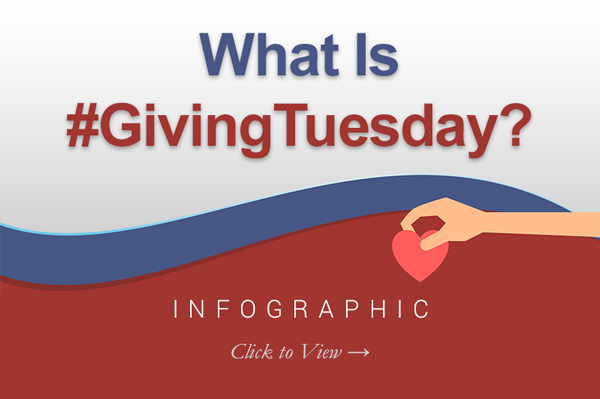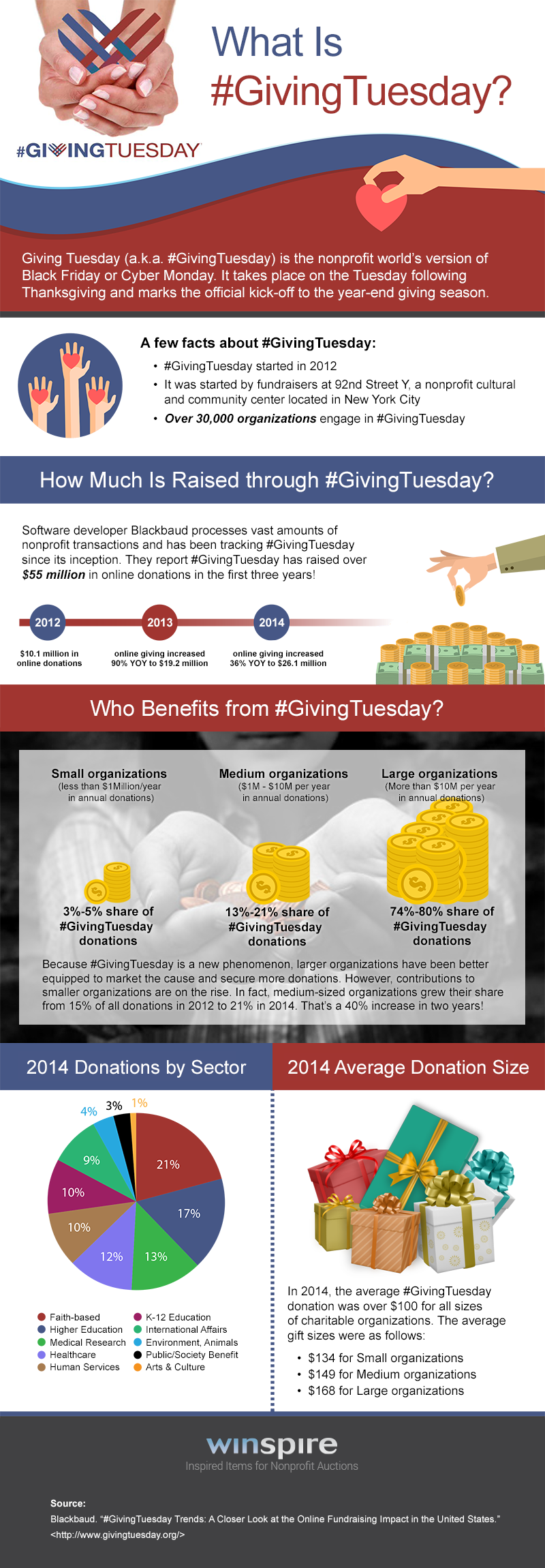Giving Tuesday—the latest iteration of post-Thanksgiving spending days (think Black Friday, Small Business Saturday and Cyber Monday)—is a global online movement dedicated to giving back. The occasion puts the spotlight on generosity, inspiring people around the world to invest in causes they believe in.
Since its inception in 2012, more than $55 million has been raised to support over 10,000 participating organizations.
On November 29th, 2016, your nonprofit will get the unique chance to engage a wide range of supporters with a Giving Tuesday campaign, setting the bar for the holiday giving season to come.
There’s only 41 days (6 weeks) left until the big day!
Is your organization ready?
Check out today’s infographic to see the huge impact Giving Tuesday has on global philanthropy, then get 4 quick strategies for nonprofits of any size to tap into its momentum.
As you can see, the popularity and awareness of Giving Tuesday has grown year after year. Here are 4 easy ways your nonprofit can capitalize on the trend.
1. Keep your campaign simple (and online)
Giving Tuesday is meant to engage as many people as possible—both major donors and casual supporters. For simplicity’s sake, skip the graphic designer and pricey donation envelopes. Focus instead on creating a sleek, high quality email campaign. Blackbaud reported a 52% increase in the amount of online donations during Giving Tuesday 2015 compared to 2014, indicating a majority of donors will participate from their laptops and phones.
To do: Send just 1 to 2 emails explaining the idea behind Giving Tuesday and how donations will be used. (Check out this sample Giving Tuesday email from Blackbaud; it’s straightforward, clear and concise.) Then, direct readers to a donation form and landing page specifically branded to Giving Tuesday.
Bonus: Use language that conveys the urgency of the campaign, such as incorporating a ticking countdown or describing the campaign as “one day only.”
{{cta(‘a863acea-3a33-419d-8ec8-54a3892e78aa’,’justifycenter’)}}
2. Go social
One reason Giving Tuesday is able to draw in new donors is the social and online nature of the movement. You’ll commonly see the day referenced as #GivingTuesday; the idea is to get the term trending on Facebook and Twitter, plus make those posts easily searchable.
To do: Prepare social media posts using the hashtag; even better if they are accompanied by images and video. You never know how your posts may spark curiosity in online “passerbys” that weren’t previously aware of your organization.
Bonus: Encourage current supporters to repost from their own accounts.
{{cta(’55cbcb9e-f865-47b8-bc59-49f07a4b0037′,’justifycenter’)}}
3. Offer other ways to get involved
Most people will participate through a one-time donation. However, depending on the nature of your nonprofit, you can open this up and offer other ways to contribute as well. Hands-on volunteer opportunities, for example, benefit not only your organization practically but also deepen the donor relationship much more significantly than a simple financial transaction.
To do: Brainstorm non-monetary ways people can participate. Try setting up a special volunteer experience for Giving Tuesday (whether it’s sorting a food pantry, doing administrative work, interacting with patients and more); collecting in-kind auction items for upcoming events; offering tours of the building…the sky’s the limit as to how supporters can engage with your mission.
Bonus: Save the contact information from all non-monetary Giving Tuesday participants as your starting list for future event volunteers.
{{cta(‘f3bfc57a-4b5b-4a1f-ac62-9b87de2ca122′,’justifycenter’)}}
3. Use Giving Tuesday to kick off your year-end campaigns.
December is known to be the most popular month for giving. Thanks to Christmas giving and year-end tax deductions, over 17 percent of all donations come in during the last month. As a result, some nonprofits worry that preceding December with a Giving Tuesday campaign will cannibalize end-of-year donations.
However, this likely isn’t the case.
Blackbaud’s npENGAGE reports, “#GivingTuesday is like a special event. Donors typically see it as a one-time special gift and not part of their annual giving.” Plus, recent donors are known to be the most likely to give again; after all, they have just expressed a fresh interest in the cause.
To do: Keep posts and emails focused on the exclusive nature of the day. This is not like your other giving campaigns: It’s a global movement of giving! The more you can set the day apart from other gifts, the less likely people are to get burned out from an additional ask in the upcoming weeks.
Bonus: Segment your donors by Giving Tuesday participation. This simply means creating a separate list of Giving Tuesday givers, then personalizing your year-end campaign ask to acknowledge their recent gift. Try something like: Thanks to you, Giving Tuesday was a huge success! Double your impact with an additional gift before the year’s end and help us reach our December goal of $10,000.
{{cta(‘0d350941-6089-4be9-9c57-ec4ab09838a8′,’justifycenter’)}}
4. Follow up with totals raised.
People tend to be goal-oriented. We love seeing tasks to completion. So, donors will be interested to know how much was raised in one day—and be celebrated for their contributions.
To do: Post the totals from Giving Tuesday on social media, in an email newsletter and/or on the website. You may want to wait a few days for any last-minute donations earmarked for Giving Tuesday.
Bonus: Call out major individual donors and gifts with dedicated social media posts, Tweets and more to further incentivize generous participation.
{{cta(‘d310ffc6-a286-481e-8afd-0cfc53a3ec20′,’justifycenter’)}}
It’s well known that the holidays are “the most generous time of the year.” Fuzzy-warm feelings of family, love and gratitude abound at this time, and the materialistic sideshow of the holidays have become less and less fulfilling.
By choosing to participate in Giving Tuesday, your nonprofit is giving supporters the chance to make an immediate, positive impact with their dollars.
{{cta(‘f82a5467-7b49-46ae-9e35-96b6d29291a8′,’justifycenter’)}}


